In the last post in our summer series on recent film books, EFSP has another Dutch curiosity. A novel about a legendary diva of the international opera houses who had vowed never to marry, who meets a heartbreaker with the angelic face that caused a furore on the stage. In 'De eerste vrouw' (The First Woman, 2016), Susan Smit depicts the tumultuous and love story between the American Geraldine Ferrar and the Dutchman Lou Tellegen, who starred together in three silent Hollywood films. Smit based her exciting novel on historical factual material.

Book cover for Susan Smit, 'De eerste vrouw' (2016). Publisher: Lebowski, Amsterdam.

German postcard by G.G. & Co., no. 478/4. Photo: Gerlach.
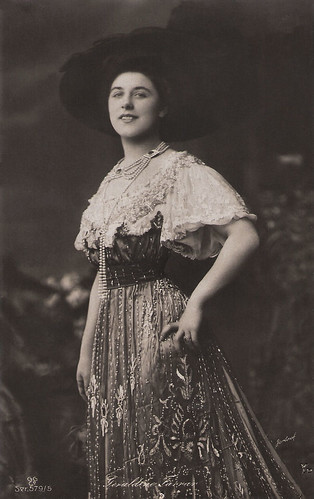
German postcard by G.G. & Co., no. 579/5. Photo: Gerlach.

German postcard by G.G. & Co., no. 2414. Photo: Photo: Geraldine Farrar as Mignon in the opera 'Mignon'. Collection: Didier Hanson.
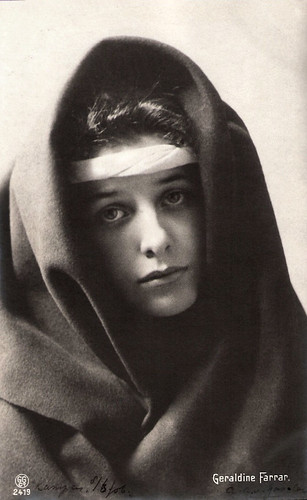
German postcard by G.G. & Co., no. 2419.
Susan Smit unfolds in 'De eerste vrouw' the love story in two parts. First she tells about the years before Hollywood, in alternating chapters on the careers and lifes of 'Lou' and 'Geraldine'. At the end the two meet at an elegant party in Holland House in New Tork. They immediately fall in love.
Alice Geraldine Farrar (1882-1967) had always been noted for her glamorous beauty, her acting talent, and the timbre of her voice. At 5 she already began studying music in Boston and by 14 was giving recitals. Barely 20, she was the toast of Berlin.
Farrar had created a sensation in 1901 at the Berlin Hofoper with her debut as Marguerite in Charles Gounod's 'Faust'. She remained with the company for three years, during which time she appeared in the title roles of Ambroise Thomas' 'Mignon' and Jules Massenet's 'Manon', as well as Juliette in Gounod's 'Roméo et Juliette'. Her admirers in Berlin included Crown Prince Wilhelm of Germany, with whom she is believed to have had a relationship beginning in 1903.
This Berlin period was interspersed with three seasons with the Monte Carlo Opera. Highlights were Pietro Mascagni's 'Amica' (1905), and Giuseppe Verdi's 'Rigoletto' (1906) in which she appeared with Enrico Caruso. In 1906, she also made her debut at the New York Metropolitan Opera in 'Roméo et Juliette'. The success placed her on a plateau with Caruso as a box-office magnet. The next year, she got raves for her performance as Cio-Cio-San in the Metropolitan premiere of Giacomo Puccini's 'Madama Butterfly' in 1907.
Geraldine Farrar had a seven-year love affair with the Italian conductor of the Met, Arturo Toscanini. It was rumored that she gave him an ultimatum that he must choose either her or his wife and children in Italy. It resulted in Toscanini's abrupt resignation as principal conductor of the Metropolitan Opera in 1915. Farrar was close friends with star tenor Enrico Caruso and there has been speculation that they too had a love affair, but no conclusive evidence of this has surfaced. At the Met, Farrar had a large following among young women, who were nicknamed ‘Gerry-flappers’. Farrar created the title roles in Puccini's 'Suor Angelica' (1918), Umberto Giordano's 'Madame Sans-Gêne' (1915), as well as the Goosegirl in Engelbert Humperdinck's 'Königskinder' (1910).
Her biographer Elizabeth Nash: “Unlike most of the famous bel canto singers of the past who sacrificed dramatic action to tonal perfection, she was more interested in the emotional than in the purely lyrical aspects of her roles.” Farrar remained a member of the company until her retirement in 1922, singing 29 roles there in 672 performances.
Geraldine Farrar also starred in more than a dozen silent films from 1915 to 1920, which were filmed between opera seasons. Farrar made her debut with the title role in Cecil B. De Mille's Carmen (1915), based on the novella 'Carmen' by Prosper Mérimée. For her role as the seductive gypsy girl she was extensively praised. DeMille directed her next in the silent romantic drama Temptation (Cecil B. DeMille, 1915), also with Theodore Roberts, and in the drama Maria Rosa (Cecil B. DeMille, 1916) with Wallace Reid.
Another notable screen role was as Joan of Arc in Joan the Woman (1917). This was Cecil B. DeMille's first historical drama. The screenplay is based on Friedrich Schiller's 1801 play 'Die Jungfrau von Orleans' (The Maid of Orleans).
She next played the daughter of an Aztec king in the silent romance The Woman God Forgot (Cecil B. DeMille, 1917). In the film she falls in love with a Spanish captain (Wallace Reid) whose army has come to convert the Aztecs to Christianity. Her last film for Paramount Pictures was the romance The Devil-Stone (Cecil B. DeMille, 1917), again with Wallace Reid. The film had sequences filmed in the Handschiegl Color Process, but only two of six reels are known to survive.
For Goldwyn Pictures, she appeared in such films as The Turn of the Wheel (Reginald Barker, 1918) with Herbert Rawlinson and Percy Marmont, the Western The Hell Cat (Reginald Barker, 1918), Shadows (Reginald Barker, 1918) and the melodrama The Stronger Vow (Reginald Barker, 1919), the latter three with Milton Sills. All four films are considered lost.
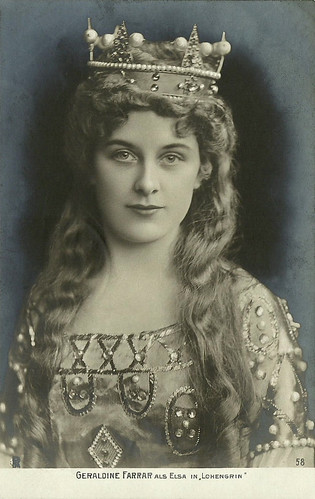
Vintage postcard, no. 58. Photo: Geraldine Farrar as Elsa in the opera 'Lohengrin'by Richard Wagner. Collection: Didier Hanson.
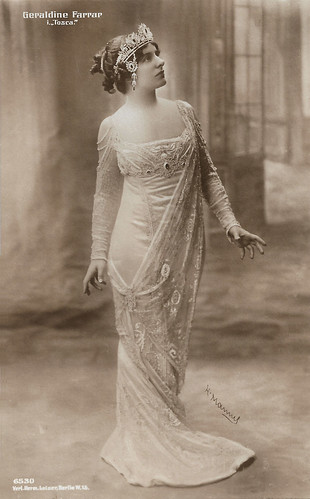
German postcard by Verlag Herm. Leiser, Berlin, no. 6530. Photo: H. Manuel. Geraldine Farrar as Tosca in the opera 'Tosca'.

French postcard. Photo: Geraldine Farrar as Mignon in the opera 'Mignon'.

German postcard by Photochemie, Berlin, no. 251. Photo: Zander und Labisch. Geraldine Farrar as Angela in 'Le Domino Noir' (1905).

German postcard by GG Cie, no. 5050. Geraldine Farrar as Madam Butterfly in 'Madama Butterfly' (1907).
Lou Tellegen (1883-1934) was the illegitimate child of former army lieutenant Isidor Louis Bernard Edmon Tellegen and actress Anna Maria van Dommelen. In 1903, Lou made his stage debut in Rotterdam.
He moved to Brussels and later to Paris, where he worked as a model for such artists as Lacroix, Constantin Meunier and Auguste Rodin, and as a prize-boxer. He studied at the Conservatoire Nationale de Musique et de Déclamation, and worked for the Theatre de l'Odéon under André Antoine, the innovative founder of the Théâtre Libre.
Later he met dandy-actor Edouard de Max, who introduced him to Sarah Bernhardt. Eventually Lou co-starred in several roles with the Divine Sarah, and was also romantically involved with her. In 1910, he made his film debut as Armand Duval alongside Bernhardt in La dame aux camélias/Camille (Louis Mercanton, 1911), a French silent film based on the play by Alexandre Dumas, fils.
In 1910, Tellegen and Bernhardt travelled to the United States to appear on stage in 'Jeanne d’Arc' (Joan of Arc). Back in France, in 1912 they made their second film together, Les Amours de la reine Élisabeth/ Queen Elizabeth (Henri Desfontaines, Louis Mercanton, 1912). The film was an adaptation of a play by Émile Moreau about episodes of the life of Elizabeth I, Queen of England (1533-1603), and focused on her ill-fated love affair with Robert Devereux, Earl of Essex (Tellegen).
The film was an enormous success in the U.S., where it was distributed by Adolph Zukor. The following year, Bernhardt and Tellegen appeared again together in Adrienne Lecouvreur/An Actress's Romance (Henri Desfontaines, Louis Mercanton, 1913). The latter is considered a lost film. In the summer of 1913, Lou Tellegen went to London where he produced, directed and starred in the Oscar Wilde play 'The Picture of Dorian Gray'.
Invited back to the United States, Lou Tellegen worked in theatre and soon became a matinee idol. His leading role in the melodrama 'Maria Rosa' was a spectacular success. Samuel Goldwyn, Financial director of the Jesse L. Lasky Feature Play Company at the time, saw, Tellegen in 1915 in this play and offered him a contract for six films.
His American film début was The Explorer (George Melford, 1915), followed by The Unknown (George Melford, 1915), both with Dorothy Davenport as his co-star. The handsome Tellegen starred in numerous silent films opposite such stars as Sessue Hayakawa, in The Victoria Cross (Edward LeSaint, 1916), and Nell Shipman, in The Black Wolf (Frank Reicher, 1917).

British postcard by Real Photograph in the Picturegoer series, London, no. 212.

British postcard in the Picturegoer Series, no. 212a.

Austrian postcard by Iris Verlag, no. 921. Photo: Fox Film.
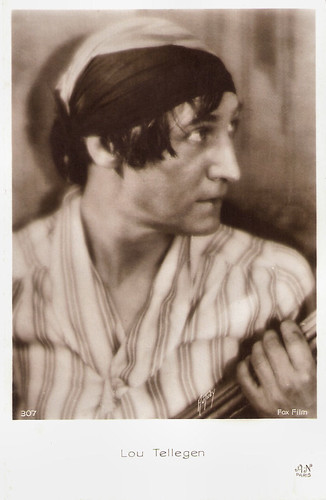
French postcard by A.N., Paris, no. 307. Photo: Max Munn Autrey / Fox Film.
In 1916, the opera diva turned film actress and the matinee idol married. They appeared in three films together: The World and Its Woman (Frank Lloyd, 1919), Flame of the Desert (Reginald Barker, 1919) and The Woman and the Puppet (Reginald Barker, 1920). Farrar's final film was the silent drama The Riddle: Woman (Edward José, 1920), in which her co-star was Montagu Love.
Lou Tellegen became an American citizen in 1918. He combined his work in the cinema with a successful stage career. Tellegen also worked as a producer and co-wrote two successful plays - 'Blind youth' (1917) with Willard Mack and 'The lust of gold' (1919) with Andor Garvay – which earned him a lot of money.
Tellegen was considered one of the best-looking actors of the silent screen, although our postcards don't confirm this. He was jealous about Farrar's successes and could not stand to be in her shadow. He started to drink and gamble, and numerous affairs followed. His marriage with Farrar became the source of considerable scandal. It ended in a messy and very public divorce in 1923.
Geraldine Farrar retired from opera in 1922 at the age of 40. Her final performance was as Leoncavallo's 'Zazà'. By this stage, her voice was in premature decline due to overwork. She quickly transitioned into concert recitals, and was signed (within several weeks of announcing her opera retirement) to an appearance at Hershey Park on Memorial Day 1922. She continued to make recordings and give recitals throughout the 1920s.
Lou Tellegen appeared in numerous silent films for Vitagraph and Fox Film, including The Redeeming Sin (J. Stuart Blackton, 1925) with Alla Nazimova, and Parisian Love (Louis J. Gasnier, 1925) with Clara Bow.
One of his memorable roles was as the corrupt Sheriff in John Ford's classic Western Three Bad Men (1926), wearing a white hat instead of the stereotypical bad guy black hat. He also directed a film starring Dolores del Rio, No Other Woman (Lou Tellegen, 1928), but it was not a success.
After his face was damaged in a hotel fire in 1929 and sound film had areived, Lou Tellegen’s fame faded. Among his rare sound film appearances were a supporting part in the crime film Enemies of the Law (Lawrence C. Windom, 1931) with Mary Nolan, and a bit part in Caravane (Erik Charell, 1934) starring Charles Boyer.
Employment was not forthcoming and debt-ridden, he went bankrupt. He was diagnosed with cancer, though this information was kept from him, and he became despondent. In 1934, Tellegen locked himself in the bathroom of a mansion of a female admirer in Los Angeles. He shaved and powdered his face, and while standing in front of a full-length mirror, he committed harakiri by stabbing himself seven times with a pair of golden scissors (which had his name engraved on them).
When asked to comment on Tellegen's death, Geraldine Farrar replied candidly: "Why should that interest me?" The Tellegen interlude, the prima donna claimed long ago, left only "a surface scar." Smit imagines that Farrar must have been devastated. The handsome Dutchman had been the love of her life. She never remarried and had no children. In 1967, Farrar died in Ridgefield, Connecticut of heart disease, aged 85.
Susan Smit beautifully imagines Tellegen's and Farrar's boundless ambition, their doubts, fears and their passionate love that was doomed to fail. But at the same time the novel is the story of an exciting time in which Europe loses its innocence in a horrible war; the women's movement is slowly gaining ground, and a mass medium sees the light of day that changed the world forever: the cinema.

German postcard by K.V.i.B., Dess, no. 1016.

German postcard by PH, no. 4116/1. Geraldine Farrar as Marguerite in Charles Gounod's opera 'Faust'.
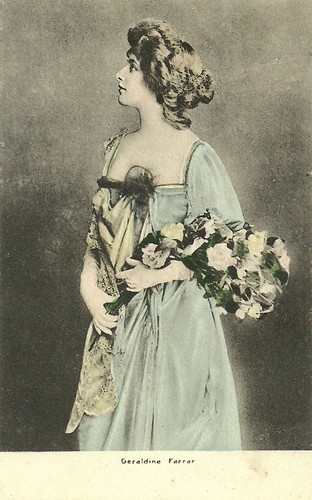
German postcard by K.V.i.B. 12. Dess., no. 4017.

French postcard, sent by mail in 1907. Geraldine Farrar in the opera 'Mignon'.

French postcard. Publicity for Vins Désiles. Photo SIP, Boyer. G. Farrar de l'Opéra Impéraile de Berlin. Caption: J'ai plaisir à recommander l'excellent Vin Désiles (I enjoy recommending the excellent V.D.).
Sources: Book, Bob Bertina (Lou Tellegen. Een Hollander in Hollywood, VN Bijlage 1985 - Dutch), A.J.C.M. Gabriëls (Institute of Netherlands History), Andrea Suhm-Binder (Cantabile subito), Bob Hufford (Find A Grave), Wikipedia and IMDb.

Book cover for Susan Smit, 'De eerste vrouw' (2016). Publisher: Lebowski, Amsterdam.

German postcard by G.G. & Co., no. 478/4. Photo: Gerlach.

German postcard by G.G. & Co., no. 579/5. Photo: Gerlach.

German postcard by G.G. & Co., no. 2414. Photo: Photo: Geraldine Farrar as Mignon in the opera 'Mignon'. Collection: Didier Hanson.

German postcard by G.G. & Co., no. 2419.
The toast of Berlin
Susan Smit unfolds in 'De eerste vrouw' the love story in two parts. First she tells about the years before Hollywood, in alternating chapters on the careers and lifes of 'Lou' and 'Geraldine'. At the end the two meet at an elegant party in Holland House in New Tork. They immediately fall in love.
Alice Geraldine Farrar (1882-1967) had always been noted for her glamorous beauty, her acting talent, and the timbre of her voice. At 5 she already began studying music in Boston and by 14 was giving recitals. Barely 20, she was the toast of Berlin.
Farrar had created a sensation in 1901 at the Berlin Hofoper with her debut as Marguerite in Charles Gounod's 'Faust'. She remained with the company for three years, during which time she appeared in the title roles of Ambroise Thomas' 'Mignon' and Jules Massenet's 'Manon', as well as Juliette in Gounod's 'Roméo et Juliette'. Her admirers in Berlin included Crown Prince Wilhelm of Germany, with whom she is believed to have had a relationship beginning in 1903.
This Berlin period was interspersed with three seasons with the Monte Carlo Opera. Highlights were Pietro Mascagni's 'Amica' (1905), and Giuseppe Verdi's 'Rigoletto' (1906) in which she appeared with Enrico Caruso. In 1906, she also made her debut at the New York Metropolitan Opera in 'Roméo et Juliette'. The success placed her on a plateau with Caruso as a box-office magnet. The next year, she got raves for her performance as Cio-Cio-San in the Metropolitan premiere of Giacomo Puccini's 'Madama Butterfly' in 1907.
Geraldine Farrar had a seven-year love affair with the Italian conductor of the Met, Arturo Toscanini. It was rumored that she gave him an ultimatum that he must choose either her or his wife and children in Italy. It resulted in Toscanini's abrupt resignation as principal conductor of the Metropolitan Opera in 1915. Farrar was close friends with star tenor Enrico Caruso and there has been speculation that they too had a love affair, but no conclusive evidence of this has surfaced. At the Met, Farrar had a large following among young women, who were nicknamed ‘Gerry-flappers’. Farrar created the title roles in Puccini's 'Suor Angelica' (1918), Umberto Giordano's 'Madame Sans-Gêne' (1915), as well as the Goosegirl in Engelbert Humperdinck's 'Königskinder' (1910).
Her biographer Elizabeth Nash: “Unlike most of the famous bel canto singers of the past who sacrificed dramatic action to tonal perfection, she was more interested in the emotional than in the purely lyrical aspects of her roles.” Farrar remained a member of the company until her retirement in 1922, singing 29 roles there in 672 performances.
Geraldine Farrar also starred in more than a dozen silent films from 1915 to 1920, which were filmed between opera seasons. Farrar made her debut with the title role in Cecil B. De Mille's Carmen (1915), based on the novella 'Carmen' by Prosper Mérimée. For her role as the seductive gypsy girl she was extensively praised. DeMille directed her next in the silent romantic drama Temptation (Cecil B. DeMille, 1915), also with Theodore Roberts, and in the drama Maria Rosa (Cecil B. DeMille, 1916) with Wallace Reid.
Another notable screen role was as Joan of Arc in Joan the Woman (1917). This was Cecil B. DeMille's first historical drama. The screenplay is based on Friedrich Schiller's 1801 play 'Die Jungfrau von Orleans' (The Maid of Orleans).
She next played the daughter of an Aztec king in the silent romance The Woman God Forgot (Cecil B. DeMille, 1917). In the film she falls in love with a Spanish captain (Wallace Reid) whose army has come to convert the Aztecs to Christianity. Her last film for Paramount Pictures was the romance The Devil-Stone (Cecil B. DeMille, 1917), again with Wallace Reid. The film had sequences filmed in the Handschiegl Color Process, but only two of six reels are known to survive.
For Goldwyn Pictures, she appeared in such films as The Turn of the Wheel (Reginald Barker, 1918) with Herbert Rawlinson and Percy Marmont, the Western The Hell Cat (Reginald Barker, 1918), Shadows (Reginald Barker, 1918) and the melodrama The Stronger Vow (Reginald Barker, 1919), the latter three with Milton Sills. All four films are considered lost.

Vintage postcard, no. 58. Photo: Geraldine Farrar as Elsa in the opera 'Lohengrin'by Richard Wagner. Collection: Didier Hanson.

German postcard by Verlag Herm. Leiser, Berlin, no. 6530. Photo: H. Manuel. Geraldine Farrar as Tosca in the opera 'Tosca'.

French postcard. Photo: Geraldine Farrar as Mignon in the opera 'Mignon'.

German postcard by Photochemie, Berlin, no. 251. Photo: Zander und Labisch. Geraldine Farrar as Angela in 'Le Domino Noir' (1905).

German postcard by GG Cie, no. 5050. Geraldine Farrar as Madam Butterfly in 'Madama Butterfly' (1907).
Romantically involved with the Divine Sarah
Lou Tellegen (1883-1934) was the illegitimate child of former army lieutenant Isidor Louis Bernard Edmon Tellegen and actress Anna Maria van Dommelen. In 1903, Lou made his stage debut in Rotterdam.
He moved to Brussels and later to Paris, where he worked as a model for such artists as Lacroix, Constantin Meunier and Auguste Rodin, and as a prize-boxer. He studied at the Conservatoire Nationale de Musique et de Déclamation, and worked for the Theatre de l'Odéon under André Antoine, the innovative founder of the Théâtre Libre.
Later he met dandy-actor Edouard de Max, who introduced him to Sarah Bernhardt. Eventually Lou co-starred in several roles with the Divine Sarah, and was also romantically involved with her. In 1910, he made his film debut as Armand Duval alongside Bernhardt in La dame aux camélias/Camille (Louis Mercanton, 1911), a French silent film based on the play by Alexandre Dumas, fils.
In 1910, Tellegen and Bernhardt travelled to the United States to appear on stage in 'Jeanne d’Arc' (Joan of Arc). Back in France, in 1912 they made their second film together, Les Amours de la reine Élisabeth/ Queen Elizabeth (Henri Desfontaines, Louis Mercanton, 1912). The film was an adaptation of a play by Émile Moreau about episodes of the life of Elizabeth I, Queen of England (1533-1603), and focused on her ill-fated love affair with Robert Devereux, Earl of Essex (Tellegen).
The film was an enormous success in the U.S., where it was distributed by Adolph Zukor. The following year, Bernhardt and Tellegen appeared again together in Adrienne Lecouvreur/An Actress's Romance (Henri Desfontaines, Louis Mercanton, 1913). The latter is considered a lost film. In the summer of 1913, Lou Tellegen went to London where he produced, directed and starred in the Oscar Wilde play 'The Picture of Dorian Gray'.
Invited back to the United States, Lou Tellegen worked in theatre and soon became a matinee idol. His leading role in the melodrama 'Maria Rosa' was a spectacular success. Samuel Goldwyn, Financial director of the Jesse L. Lasky Feature Play Company at the time, saw, Tellegen in 1915 in this play and offered him a contract for six films.
His American film début was The Explorer (George Melford, 1915), followed by The Unknown (George Melford, 1915), both with Dorothy Davenport as his co-star. The handsome Tellegen starred in numerous silent films opposite such stars as Sessue Hayakawa, in The Victoria Cross (Edward LeSaint, 1916), and Nell Shipman, in The Black Wolf (Frank Reicher, 1917).

British postcard by Real Photograph in the Picturegoer series, London, no. 212.

British postcard in the Picturegoer Series, no. 212a.

Austrian postcard by Iris Verlag, no. 921. Photo: Fox Film.

French postcard by A.N., Paris, no. 307. Photo: Max Munn Autrey / Fox Film.
A messy and very public divorce
In 1916, the opera diva turned film actress and the matinee idol married. They appeared in three films together: The World and Its Woman (Frank Lloyd, 1919), Flame of the Desert (Reginald Barker, 1919) and The Woman and the Puppet (Reginald Barker, 1920). Farrar's final film was the silent drama The Riddle: Woman (Edward José, 1920), in which her co-star was Montagu Love.
Lou Tellegen became an American citizen in 1918. He combined his work in the cinema with a successful stage career. Tellegen also worked as a producer and co-wrote two successful plays - 'Blind youth' (1917) with Willard Mack and 'The lust of gold' (1919) with Andor Garvay – which earned him a lot of money.
Tellegen was considered one of the best-looking actors of the silent screen, although our postcards don't confirm this. He was jealous about Farrar's successes and could not stand to be in her shadow. He started to drink and gamble, and numerous affairs followed. His marriage with Farrar became the source of considerable scandal. It ended in a messy and very public divorce in 1923.
Geraldine Farrar retired from opera in 1922 at the age of 40. Her final performance was as Leoncavallo's 'Zazà'. By this stage, her voice was in premature decline due to overwork. She quickly transitioned into concert recitals, and was signed (within several weeks of announcing her opera retirement) to an appearance at Hershey Park on Memorial Day 1922. She continued to make recordings and give recitals throughout the 1920s.
Lou Tellegen appeared in numerous silent films for Vitagraph and Fox Film, including The Redeeming Sin (J. Stuart Blackton, 1925) with Alla Nazimova, and Parisian Love (Louis J. Gasnier, 1925) with Clara Bow.
One of his memorable roles was as the corrupt Sheriff in John Ford's classic Western Three Bad Men (1926), wearing a white hat instead of the stereotypical bad guy black hat. He also directed a film starring Dolores del Rio, No Other Woman (Lou Tellegen, 1928), but it was not a success.
After his face was damaged in a hotel fire in 1929 and sound film had areived, Lou Tellegen’s fame faded. Among his rare sound film appearances were a supporting part in the crime film Enemies of the Law (Lawrence C. Windom, 1931) with Mary Nolan, and a bit part in Caravane (Erik Charell, 1934) starring Charles Boyer.
Employment was not forthcoming and debt-ridden, he went bankrupt. He was diagnosed with cancer, though this information was kept from him, and he became despondent. In 1934, Tellegen locked himself in the bathroom of a mansion of a female admirer in Los Angeles. He shaved and powdered his face, and while standing in front of a full-length mirror, he committed harakiri by stabbing himself seven times with a pair of golden scissors (which had his name engraved on them).
When asked to comment on Tellegen's death, Geraldine Farrar replied candidly: "Why should that interest me?" The Tellegen interlude, the prima donna claimed long ago, left only "a surface scar." Smit imagines that Farrar must have been devastated. The handsome Dutchman had been the love of her life. She never remarried and had no children. In 1967, Farrar died in Ridgefield, Connecticut of heart disease, aged 85.
Susan Smit beautifully imagines Tellegen's and Farrar's boundless ambition, their doubts, fears and their passionate love that was doomed to fail. But at the same time the novel is the story of an exciting time in which Europe loses its innocence in a horrible war; the women's movement is slowly gaining ground, and a mass medium sees the light of day that changed the world forever: the cinema.

German postcard by K.V.i.B., Dess, no. 1016.

German postcard by PH, no. 4116/1. Geraldine Farrar as Marguerite in Charles Gounod's opera 'Faust'.

German postcard by K.V.i.B. 12. Dess., no. 4017.

French postcard, sent by mail in 1907. Geraldine Farrar in the opera 'Mignon'.

French postcard. Publicity for Vins Désiles. Photo SIP, Boyer. G. Farrar de l'Opéra Impéraile de Berlin. Caption: J'ai plaisir à recommander l'excellent Vin Désiles (I enjoy recommending the excellent V.D.).
Sources: Book, Bob Bertina (Lou Tellegen. Een Hollander in Hollywood, VN Bijlage 1985 - Dutch), A.J.C.M. Gabriëls (Institute of Netherlands History), Andrea Suhm-Binder (Cantabile subito), Bob Hufford (Find A Grave), Wikipedia and IMDb.
No comments:
Post a Comment